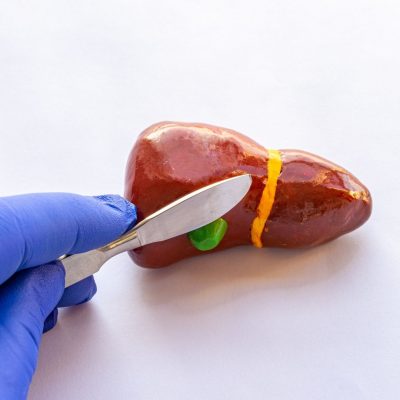Cholecystectomy
It is the process of performing the operations on the abdominal skin through small holes without making large incisions. It is also known as bloodless surgeries among the people.

What is laparoscopic surgery?
Laparoscopy is a type of surgical procedure that allows a surgeon to access the inside of the abdomen and pelvis without having to make large incisions in the skin.
What is Laparoscopic Cholecystectomy?
A laparoscopic cholecystectomy is a surgery which the doctor removes your gallbladder. This procedure uses several small cuts instead of one large one. A laparoscope, a narrow tube with a camera, is inserted through one incision.
A laparoscope, a narrow tube with a camera, is inserted through one incision. This allows your doctor to see your gallbladder on a screen. Your gallbladder is then removed through another small incision.

Gallbladder
The gallbladder is a pear-shaped organ located in the lower right part of the liver.
Its primary function is to store and concentrate bile, a yellow-brown digestive enzyme produced by the liver. After ingestion, bile is secreted to aid digestion and proceeds through narrow, tubular channels into the small intestine. Taking the gallbladder does not cause a digestive disorder in many people.
What causes gallbladder problems?
Gallstones are often the cause. These small, hard deposits form in the gallbladder. They can also get into the bile duct, which connects the gallbladder with your intestines.
- Gallstones are often the cause. These small, hard deposits form in the gallbladder.
- They can also get into the bile duct, which connects the gallbladder with your intestines.
- It is not known why some people have gallbladder problem.
- There is no specific recommendation for the prevention of gallstones
- These stones may prevent the bile from flowing out of the gallbladder, so gallbladder swells, abdominal pain, vomiting, indigestion and occasional fever may occur.
- You can get jaundice if a gallstone passes out of the gallbladder into the bile duct and blocks the flow of bile.
How to find out gallbladder problems?
- Ultrasound is often used to find gallstones.
- In complex cases, other x-ray tests may be preferred to evaluate gallbladder disease.
- Gallbladder stones do not disappear by themselves. Some of them can be temporarily eliminated with medications or diet.
- Surgical removal of the gallbladder is the safest and most convenient way to treat diseases.

What are the advantages of laparoscopic surgery?
- Instead of a 10-15 cm incision, only four small incisions to open the abdomen.
- Patients have less postoperative pain.
- Faster recovery. Most patients are discharged within a day and may return to normal activities more quickly.

Are you a candidate for laparoscopic gallbladder surgery?
Although laparoscopic surgery has many benefits, this method is not suitable for patients who have had previous abdominal surgery or have some medical conditions. Your doctor decides whether the gallbladder can be taken laparoscopically.
How to prepare?
Preparations to be made before laparoscopy are listed below, however, each patient and doctor has a unique condition:
- Preoperative preparation requires medical evaluation, blood tests, chest x-ray and ECG, depending on age and medical condition.
- The surgeon informs patient about the risks and benefits of the surgery in order to a have written approval.
- The night before surgery, you should not eat or drink anything. You can only use your prescribed medicines with the approval of your doctor. Blood thinners and anti-inflammatory drugs should be left temporarily several days or a week before surgery.
- Dietary medicines should not be taken for two weeks before surgery.
- Stop smoking.
How laparoscopic surgery is performed?
- General anesthesia is required and the patient stays asleep during the operation.
- Using a cannula (narrow, tubular instrument), the surgeon enters the abdomen through the navel.
- The laparoscope (a small telescope) connected to a special camera is inserted through the cannula so that the surgeon can see the patient’s internal organs magnified on the television screen.
- Other cannulas are used to separate the gallbladder from the surrounding tissues and remove it using one of the openings.
- Surgeons may use cholangiography to determine the location stones and their structure.
- The stones in the main bile duct can be removed by the surgeon, he/she they can choose to remove them later with a second minimally invasive surgery, or can turn the surgery on to remove all the stones.
- After removal of the gallbladder, the small incision is closed with stitches.
What happens if surgery cannot be performed laparoscopically?
Some patients are not eligible for laparoscopic surgery. Your doctor may decide to perform a open surgery because of a history of prior abdominal surgery causing dense scar tissue or bleeding problems during the operation. It is decision made by your surgeon either before or during the surgery . The decision to convert to an open procedure is strictly based on patient safety.

What to expect after gallbladder surgery?
- There would be a certain level of pain afterwards. Nausea and vomiting are common conditions.
- When fluids or diet are tolerated, the patient can go home the day he/she had surgery or might stay in the hospital overnight.
- You should be as active as your body allows. Doctors recommend walking. You may also take a shower.
- Regular activities such as driving, climbing stairs, lifting weights or working can be started within a week.
- In the case of fever, yellow skin or eyes, worsening abdominal pain, swelling, persistent nausea and vomiting you should contact your doctor.
- Most patients may return to work within seven days of laparoscopic surgery, depending on what kind of a work they do.
- If you had an open surgery, expect to go back to full activities in 4 to 6 weeks.
- You need to see your doctor 2 weeks later after surgery.
What are the possible complications?
Each surgery generally has a risk but most people who have laparoscopic gallbladder removal have few complications or none at all. Whether laparoscopic or open surgery, ask your doctor about his education and experience in this field.
Complications of laparoscopic cholecystectomy are not common, but bleeding, infection, pneumonia, blood clotting or heart problems may occur.
Gallbladder surgery could hurt nearby areas such as the common bile duct, large or small intestine. You might need another surgery if this happens. It is also possible that bile might leak into the abdomen after gallbladder surgery.
Many researches show that the complication of a laparoscopic gallbladder surgery which performed by an experienced surgeon is lower than complications of an open gallbladder surgery.

When to call your doctor?
- Continuous fever above 39 degrees
- Bleeding
- Increased abdominal distension
- Pain that cannot be relieved by drugs
- Permanent nausea and vomiting
- Chills
- Cough or breathlessness
- Redness surrounding your incisions that is worsening or getting bigger
- Inable to eat anything liquid or solid

